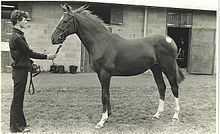Foaled 2 April 1975 Colour Chestnut Owner Carlo d'Alessio Grandsire Le Lavandou | Country Ireland Breeder McGrath Trust Company Record 15:11-2-0 Parents Le Levanstell | |
 | ||
Le Moss (3 April 1975 – 17 August 2000) was a British Thoroughbred racehorse and sire. A specialist stayer, he excelled at distances of two miles and beyond, winning eleven times from fifteen races between 1977 and 1980. He showed good form as a three-year-old, winning the Queen's Vase and finishing second in the classic St Leger Stakes, but reached his peak as an older horse. In 1979 he completed the "Stayers' Triple Crown" by winning the Ascot Gold Cup, Goodwood Cup and Doncaster Cup. He won the same three races as a five-year-old, defeating the future champion Ardross on each occasion. He was then retired to stud here he had some success as a sire of steeplechasers.
Contents
Background
Le Moss was a chestnut horse with a narrow white blaze and three white socks bred in Ireland by the Irish-based McGrath Trust Company, a breeding organisation run by Joseph McGrath. His sire was the McGrath-owned Le Levanstell, who won the Sussex Stakes and the Queen Elizabeth II Stakes in 1961 before a successful stud career. Le Moss's dam, Feemoss came from a strong staying family, being a daughter of the Yorkshire Oaks winner Feevagh and a half-sister of the Queen Alexandra Stakes winner Laurence O. Feemoss had previously produced the Prix de l'Arc de Triomphe winner Levmoss and the Prix de Diane winner Sweet Mimosa.
As a yearling, Le Moss was sent to the sales and was bought for 26,000 guineas by representatives of the Italian lawyer Carlo d'Alessio. During his racing career, Le Moss carried d'Alessio's red, white and green racing silks was trained by Henry Cecil at his Warren Place Stables at Newmarket, Suffolk. He proved a difficult horse to train, being highly temperamental and lazy in his exercise. Joe Mercer, who rode the horse to some of his biggest wins described him as "a cantankerous bugger".
1978: three-year-old season
After finishing unplaced on his only race as a two-year-old, Le Moss was a "very impressive" winner of a maiden race at Newmarket Racecourse on his first appearance in 1978. He established himself as one of the leading stayers of his generation at Royal Ascot in June when he was ridden by Geoff Baxter to win the Queen's Vase over two miles at odds of 7/4. At Goodwood Racecourse a month later he won the March Stakes over one and three quarter miles. As a result of these successes he was strongly fancied for the St Leger Stakes at Doncaster in September. He finished second of the fourteen runners, one and a half lengths behind the 28/1 outsider Julio Mariner.
1979: four-year-old season
Le Moss began his four-year-old season by beating two opponents in the Lymm Stakes over two miles at Haydock Park in May. He was then sent Royal Ascot in June, where he was ridden by Lester Piggott in the Ascot Gold Cup over two and a half miles. He started at odds of 7/4 and won by seven lengths from his six-year-old stable companion Buckskin who started favourite. He then won the Goodwood Cup over two miles five furlongs and completed the Stayers' Triple Crown by winning the Doncaster Cup over two and a quarter miles in September.
1980: five-year-old season
In early 1980, Le Moss sustained an injury and could not be galloped, being instead brought back to fitness by a programme of swimming. Le Moss did not appear until Royal Ascot where he started the 3/1 favourite to retain the Gold Cup. Ridden by Joe Mercer, he led from the start and repelled the persistent challenge of the Irish-trained four-year-old Ardross to win by three-quarters of a length. In the Goodwood Cup, Le Moss started 4/7 favourite, despite being required to concede two pounds to Ardross. In a repeat of their Ascot clash, Le Moss and Ardross dominated the closing stages of the race, with the older horse winning by half a length. The pair met for a third time in the Doncaster Cup. Le Moss led from the start and completed his second Cup hat-trick, beating his rival by a neck.
On his final appearance he was sent to France to contest the Prix Gladiateur over 4000 metres. He failed to reproduce his best form as he finished second to the filly Anifa.
Assessment
In 1980 he was officially Europe's second best older horse, and the fourth best overall with a rating of 129, placing him behind the three-year-olds Moorestyle and Argument as well as the four-year-old Ela-Mana-Mou. Following a "recalibration" of historic ratings in 2013, the ratings of all horses in the 1985 classification were moved down by four pounds, giving him a new official rating of 125.
The independent Timeform awarded Le Moss a peak rating of 135 in 1980, making him their highest-rated older horse and the second best horse of any age behind Moorestyle. They described him in their annual as "a powerful, relentless galloper".
In their book A Century of Champions, based on a modified version of the Timeform system, John Randall and Tony Morris rated Le Moss a "superior" Ascot Gold Cup winner and the second best British or Irish trained horse foaled in 1975 behind Ile de Bourbon.
Stud record
Le Moss made no impact as a sire of flat runners, but his progeny had some success in National Hunt racing. The best of his offspring was the steeplechaser Scotton Banks, who won the Peter Marsh Chase and the Martell Cup in 1996. He was also the damsire of the Cheltenham Gold Cup winner Imperial Commander. Le Moss died at the age of twenty-five at Waterhouse near Minehead in Somerset on 17 August 2000.
